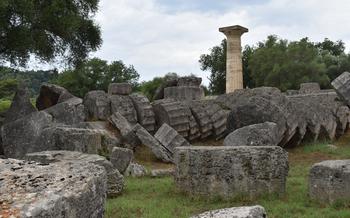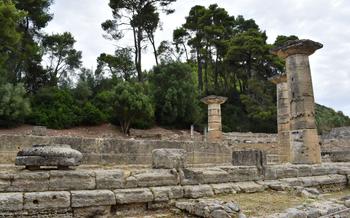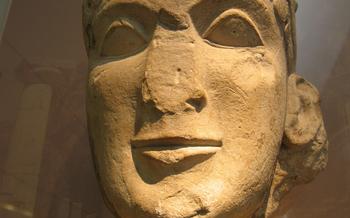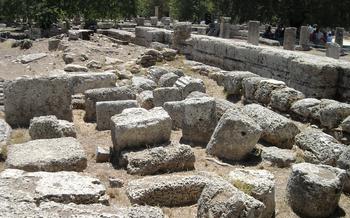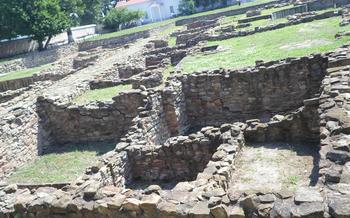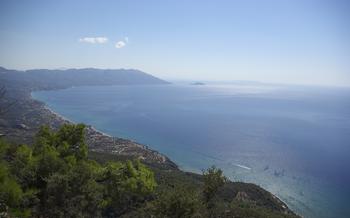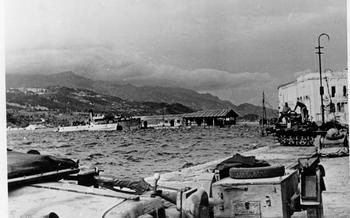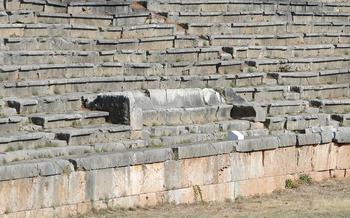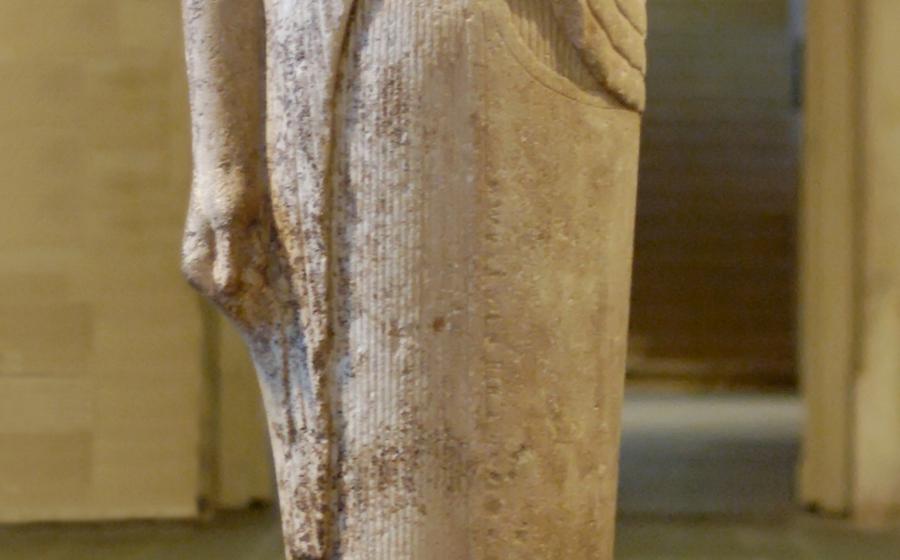
Temple of Hera (Heraion of Samos)
- Architectural Features of the Temple
- The Sacred Precinct
- Visiting the Temple of Hera
- Heraion Archaeological Museum
- UNESCO World Heritage Site
- Nearby Attractions
- Festivals and Events
- Local Cuisine and Restaurants
- Accommodation Options
- Transportation and Getting Around
- Insider Tip: Unveiling the Secrets of the Heraion
Architectural Features of the Temple
The Temple of Hera was constructed using local limestone and marble, demonstrating the exceptional craftsmanship of ancient Greek builders. The temple's massive columns, standing at an impressive height, are a testament to the engineering prowess of the time. Each column features intricate fluting, creating a visually striking effect that enhances the overall grandeur of the structure.
One of the unique architectural elements of the Temple of Hera is its double colonnade. The temple's exterior features two rows of columns, creating an impressive and distinctive façade. This design is believed to have influenced the construction of other ancient Greek temples, such as the Temple of Apollo at Didyma.
The Temple of Hera shares similarities with other ancient Greek temples, particularly those constructed during the Archaic and Classical periods. The temple's rectangular shape, with its elongated cella (inner chamber), is a common feature of Greek temple architecture. The cella was likely adorned with sculptures and other decorative elements, although these have not survived to the present day.
Overall, the architectural features of the Temple of Hera showcase the remarkable achievements of ancient Greek builders. The temple's massive columns, double colonnade, and overall design reflect the skill and artistry that characterized ancient Greek architecture.
The Sacred Precinct
The sacred precinct surrounding the Temple of Hera was an extensive and significant area that played a crucial role in ancient Greek religious practices. Enclosed by a sturdy wall, the precinct served as a sacred space dedicated to the worship of Hera and various other deities.
Within the precinct, visitors would encounter a multitude of altars, each dedicated to a specific deity or purpose. These altars were used for offerings and sacrifices, allowing worshippers to express their devotion and seek divine favor. Votive offerings, such as statues, pottery, and jewelry, were also placed within the precinct as tokens of gratitude or supplication.
Other structures within the sacred precinct included a stoa, or colonnaded walkway, which provided shelter and a place for worshippers to gather. There was also a prytaneion, a building where the sacred fire was kept burning continuously. The presence of these structures further enhanced the precinct's functionality and significance as a religious center.
The sacred precinct surrounding the Temple of Hera served as a focal point for religious rituals and ceremonies. It was a place where the community could come together to honor the gods, offer sacrifices, and seek divine guidance. The precinct's layout and features reflected the importance of religious practices in ancient Greek society and provided a tangible connection between the mortal and divine realms.
Visiting the Temple of Hera
The Temple of Hera, also known as the Heraion of Samos, is located on the southeastern coast of the island of Samos, in Greece. It is situated in a picturesque setting overlooking the Aegean Sea, surrounded by lush greenery and stunning landscapes. To visit the temple, you can take a scenic drive or bus ride from the main town of Samos, which takes approximately 30 minutes.
The temple is open to the public daily, and admission fees are very reasonable. Guided tours are available in various languages, providing insightful information about the history, mythology, and significance of the site. Visitors can explore the well-preserved ruins of the temple, including the impressive columns, the altar, and the sacred precinct.
The surrounding area offers several facilities for tourists, including a small museum, a café, and a souvenir shop. You can relax and enjoy the tranquil atmosphere of the site, take a leisurely stroll through the ancient ruins, and admire the breathtaking views of the sea and the surrounding countryside.
Visiting the Temple of Hera is a unique and enriching experience that allows you to step back in time and immerse yourself in the rich history and culture of ancient Greece. Whether you are a history buff, a mythology enthusiast, or simply someone who appreciates architectural wonders, this iconic temple is a must-see destination on the beautiful island of Samos.
Heraion Archaeological Museum
The Heraion Archaeological Museum, located a short distance from the ruins of the Temple of Hera, offers a remarkable glimpse into the history and significance of the site. Established in 1989, the museum houses a collection of artifacts that were discovered during excavations at the temple and the surrounding area.
Visitors to the museum can admire a diverse array of artifacts, including marble statues, pottery, jewelry, and coins that shed light on the religious practices, daily life, and artistic achievements of the ancient Greeks. Among the highlights of the collection is a beautifully preserved marble statue of Hera, dating back to the 6th century BC, which once adorned the temple's interior.
The museum also features a collection of votive offerings, such as terracotta figurines, bronze statuettes, and ceramic vessels, which were dedicated to Hera by worshippers seeking her favor or protection. These offerings provide insights into the deep devotion and reverence that the ancient Greeks held for their gods.
The Heraion Archaeological Museum serves as a valuable resource for scholars and history enthusiasts alike, offering a deeper understanding of the religious and cultural significance of the Temple of Hera and its place within the broader context of ancient Greece.
UNESCO World Heritage Site
The Temple of Hera is recognized as a UNESCO World Heritage Site, a prestigious designation that acknowledges its outstanding universal value. The temple meets several criteria for inclusion on the World Heritage List:
-
Cultural Significance: The Temple of Hera is a remarkable example of ancient Greek architecture and religious practices. It played a crucial role in the development of Greek civilization and the cult of Hera, a prominent goddess in Greek mythology.
-
Architectural Achievement: The temple's unique architectural features, such as its colossal scale, Ionic columns, and intricate ornamentation, showcase the exceptional craftsmanship and artistry of ancient Greek builders. It serves as a testament to their engineering prowess and the enduring legacy of Greek architecture.
-
Historical Importance: The Temple of Hera stands as a symbol of the rich history and cultural heritage of Samos. Its longevity and continuous use from the archaic period to the Roman era provide valuable insights into the evolution of religious practices and the development of the ancient city-state.
-
Authenticity and Integrity: The temple's authenticity and integrity remain largely intact despite the passage of time and natural disasters. The site has been meticulously preserved and restored, ensuring its continued significance as a cultural and historical landmark.
The inclusion of the Temple of Hera on the UNESCO World Heritage List highlights its exceptional value and the international recognition it has received for its outstanding contribution to our understanding of ancient Greek culture and architecture.
Nearby Attractions
Beyond the allure of the Temple of Hera, Samos boasts a wealth of historical and natural treasures waiting to be discovered. The ancient city of Pythagoreion, a UNESCO World Heritage Site, offers a glimpse into the life and times of the renowned philosopher and mathematician Pythagoras. Explore the ruins of the ancient city walls, admire the well-preserved Roman aqueduct, and marvel at the remnants of the ancient harbor.
For those seeking sun-soaked relaxation, Samos is home to pristine beaches and crystal-clear waters. Kokkari Beach, with its golden sands and shallow turquoise waters, is ideal for swimming, sunbathing, and water sports. Tsamadou Beach, with its secluded coves and dramatic rock formations, offers a more tranquil escape.
Nature enthusiasts can embark on scenic hikes through the island's lush interior, following ancient trails that wind through olive groves, pine forests, and cascading waterfalls. The Mount Kerkis National Park, with its diverse flora and fauna, is a haven for hikers and birdwatchers.
Day trips and excursions from Samos provide an opportunity to explore the surrounding islands and attractions. Take a boat trip to the neighboring island of Ikaria, renowned for its thermal springs and laid-back atmosphere. Visit the Fourni Islands, a picturesque archipelago with charming fishing villages and secluded bays. Or venture further afield to the ancient city of Ephesus in Turkey, a UNESCO World Heritage Site with spectacular ruins and a rich history.
Festivals and Events
The island of Samos and the Temple of Hera are vibrant and active during the summer months, hosting various festivals and events that celebrate the island's rich history, culture, and traditions. These events offer an excellent opportunity for visitors to immerse themselves in the local way of life and experience the unique atmosphere of Samos.
One of the most popular events is the Samos Wine Festival, held annually in August. This festival showcases the island's renowned winemaking tradition, with tastings, workshops, and seminars led by local winemakers. Visitors can sample a wide variety of Samos wines, including the famous sweet Muscat, and learn about the island's viticulture and wine production methods.
Another highlight is the Samos Cultural Festival, which takes place in July and features a range of cultural performances, art exhibitions, and traditional music and dance. This festival celebrates the island's rich heritage and provides a platform for local artists and performers to showcase their talents.
For those interested in history and archaeology, the Samos Archaeological Festival in September offers guided tours of the Temple of Hera and other ancient sites on the island, along with lectures and presentations by experts in the field.
These festivals and events not only offer a glimpse into the culture and traditions of Samos but also create a festive and lively atmosphere that adds to the overall visitor experience. Whether you're a history buff, a wine enthusiast, or simply looking for a fun and engaging way to explore the island, these events are not to be missed.
Local Cuisine and Restaurants
When visiting Samos and the Temple of Hera, indulging in the local cuisine is a must. The island offers a delightful array of traditional Greek dishes infused with unique flavors and fresh ingredients.
Samos's culinary scene is renowned for its use of local produce, including olives, citrus fruits, and aromatic herbs. Sample the island's specialty, "souma," a traditional spirit made from grapes or plums, often enjoyed as an aperitif or digestif.
For a memorable dining experience, head to one of the charming tavernas or restaurants near the Temple of Hera. These establishments often offer panoramic views of the Aegean Sea, creating a magical ambiance for your meal.
Be sure to try dishes such as "mousakas," a hearty casserole made with eggplant, potatoes, and minced meat, or "gemista," a delightful combination of stuffed tomatoes and peppers. Seafood lovers will relish the freshly caught fish and octopus, grilled to perfection and seasoned with olive oil and lemon.
For a sweet treat, don't miss "samiotiko glyko," a traditional sweet made from almonds and honey, or "loukoumades," delicious fried dough balls drizzled with honey and cinnamon.
When dining out in Samos, embrace the local customs and traditions. Take your time savoring each dish, and don't be afraid to ask for recommendations or try new flavors. The warm hospitality of the locals will make your culinary journey an unforgettable experience.
Accommodation Options
When planning your visit to the Temple of Hera, you'll find a range of accommodation options to suit different preferences and budgets. Whether you're seeking a comfortable stay in a cozy guesthouse or a luxurious experience in a beachfront resort, Samos has you covered.
For a budget-friendly option, consider the Samos Hotel, located a short walk from the temple. This family-run hotel offers clean and comfortable rooms with basic amenities at an affordable price.
For a mid-range option, the Heraion Hotel is an excellent choice. Situated near the temple, this hotel provides modern rooms with balconies overlooking the sea. Guests can enjoy a refreshing swim in the outdoor pool or relax in the spacious lounge.
If you're looking for a luxurious experience, the Grand Hotel Samos is the ultimate choice. This five-star hotel offers opulent rooms and suites with stunning sea views. Indulge in world-class dining at the hotel's restaurants, unwind at the spa, or take a dip in the private beach.
Budget-conscious travelers can find affordable hostels and guesthouses in Pythagorio, the main town of Samos. These accommodations offer a friendly atmosphere and a chance to connect with fellow travelers.
To ensure a comfortable stay, it's advisable to book your accommodation in advance, especially during the peak tourist season. Online booking platforms and local travel agencies can assist you in finding the best deals and availability.
Transportation and Getting Around
Reaching Samos and the Temple of Hera is a breeze. The island is well-connected by air and sea, with regular flights and ferries from Athens and other major Greek cities. Once on the island, the temple is easily accessible by car or public transportation. Car rentals are widely available, offering flexibility and independence to explore the island at your own pace. If you prefer a more relaxed approach, the local bus network provides convenient transportation to the temple and other attractions.
For those arriving by air, Samos International Airport (SMI) is located just 16 kilometers from the temple. From the airport, you can catch a taxi or hop on the public bus that runs between the airport and the main town of Vathy. The bus stop is conveniently located right outside the airport terminal.
If you're coming by sea, the port of Vathy is the main gateway to Samos. Ferries from Athens and other islands dock here regularly. From the port, you can take a taxi or catch the public bus to the temple. The bus stop is a short walk from the ferry terminal.
Once you're at the temple, there's ample parking space available for both cars and tour buses. So, whether you choose to drive yourself or join a guided tour, you'll have no trouble finding a spot to leave your vehicle.
Insider Tip: Unveiling the Secrets of the Heraion
As you explore the ruins of the Temple of Hera, keep an eye out for a hidden gem that lies just a short walk away. Nestled among the olive groves, you'll find the ancient quarry where the massive stone blocks used to construct the temple were extracted. This quarry offers a fascinating glimpse into the engineering prowess of the ancient Greeks and provides a unique opportunity to see where the temple's stones originated.
For a truly immersive experience, visit the Temple of Hera during the annual "Heraia" festival, held in honor of the goddess. This vibrant celebration features traditional music, dancing, and theatrical performances that bring the ancient myths and legends to life. Immerse yourself in the rich cultural heritage of Samos as you witness the procession of costumed participants carrying offerings to the temple, just as the ancient Greeks did centuries ago.
To capture stunning photographs of the Temple of Hera, visit during the golden hours of sunrise or sunset. The warm hues of the setting sun cast a magical glow on the ancient ruins, creating a breathtaking backdrop for your shots. Remember to bring your tripod to stabilize your camera and capture sharp, blur-free images.
Make the most of your time in Samos by exploring the island's other hidden treasures. Discover secluded beaches with crystal-clear waters, hike through scenic mountain trails, and visit charming villages nestled amidst lush greenery. Engage with the friendly locals, savor the delicious local cuisine, and immerse yourself in the vibrant culture of this beautiful Greek island.

